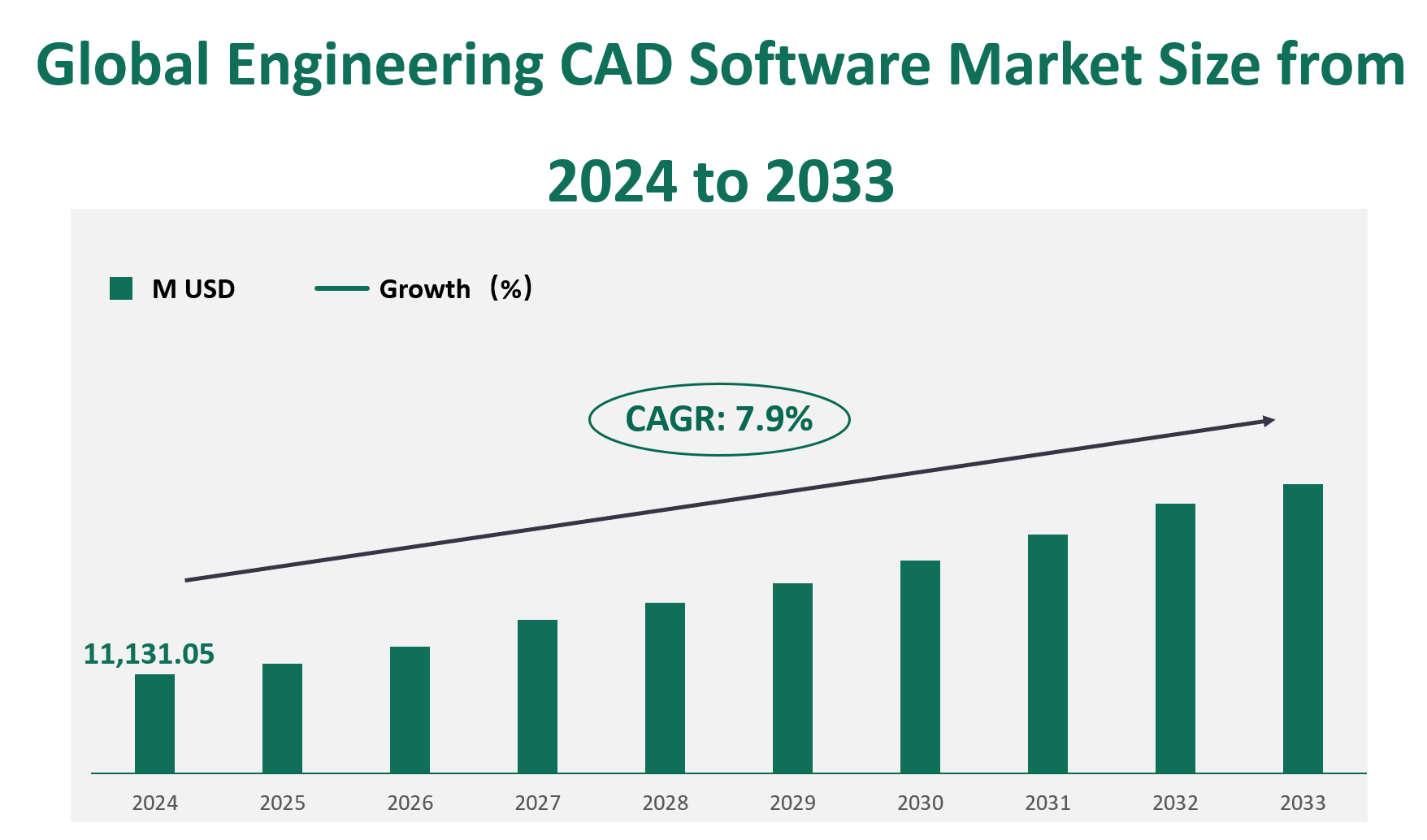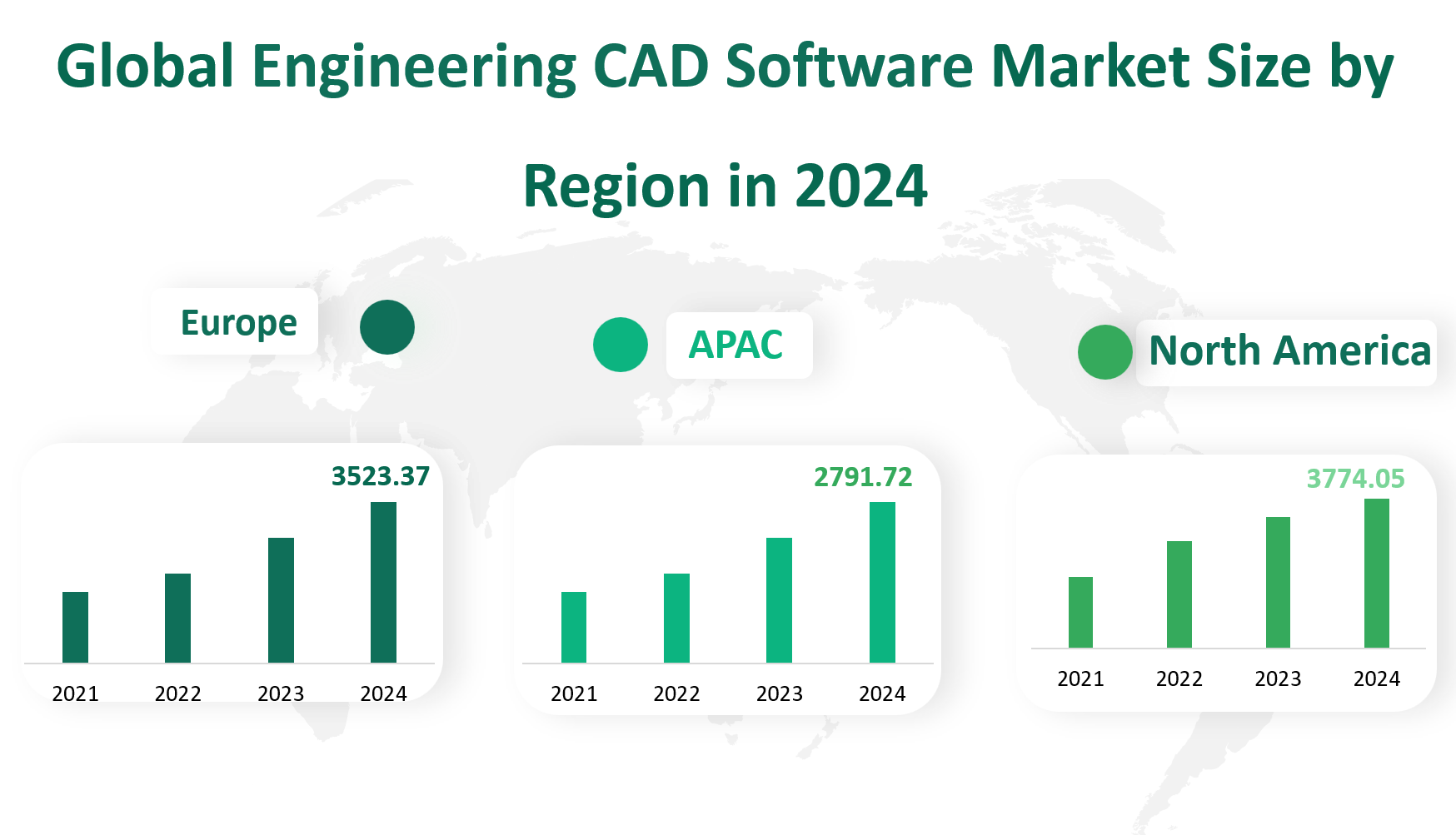1. Global Engineering CAD Software Market Insight Analysis
In 2024, the global Engineering CAD Software market is projected to reach a value of $11,131.05 million (USD), with a Compound Annual Growth Rate (CAGR) of 7.90% from 2024 to 2033.
Engineering CAD Software, or Computer-Aided Design Software, is a powerful tool used by engineers and designers to create detailed 2D and 3D models of various products and structures. It allows for the precise creation of technical drawings and designs, enabling professionals to visualize, simulate, and analyze their projects before actual production. This software is widely used in industries such as architecture, mechanical design, automotive, aerospace, and electronics. It not only enhances productivity but also reduces costs and time-to-market by enabling virtual prototyping and simulations. The ability to create and modify designs quickly and accurately makes Engineering CAD Software an indispensable tool in modern engineering and design processes.
Figure Global Engineering CAD Software Market Size (M USD) and CAGR (2024-2033)

2. Driving and Limiting Factors of Engineering CAD Software Market Growth
Increasing Demand from Downstream Industries: The construction, automotive, and manufacturing sectors are major consumers of Engineering CAD Software. As these industries continue to grow and evolve, the demand for advanced design and simulation tools also increases. For example, the rapid urbanization in emerging economies has led to a surge in construction projects, driving the need for sophisticated CAD software to manage complex designs and ensure precision.
Technological Advancements: The integration of CAD software with other technologies such as 3D printing, virtual reality (VR), and augmented reality (AR) has expanded its applications and benefits. These advancements allow for more immersive and interactive design experiences, further enhancing the value of CAD software in various industries.
Government Support and Regulations: Governments in many countries are promoting the adoption of advanced technologies to boost productivity and innovation. For instance, policies encouraging the use of Building Information Modeling (BIM) in construction projects have indirectly driven the demand for Engineering CAD Software.
High Costs and Complexity: High-end Engineering CAD Software solutions are often expensive, both in terms of initial purchase costs and ongoing maintenance fees. Additionally, the software requires specialized training and expertise to operate effectively, which can be a barrier for small and medium-sized enterprises (SMEs).
Compatibility and Integration Issues: Different CAD software solutions may not always be compatible with each other, leading to challenges in data sharing and collaboration. This can result in delays and inefficiencies, especially in projects involving multiple stakeholders using different software platforms.
Security Concerns: As Engineering CAD Software becomes more connected to the internet, it faces increased risks of cyberattacks. Companies need to invest in robust security measures to protect their intellectual property and sensitive design data.
3. Technology Innovation and Corporate Mergers and Acquisitions in Engineering CAD Software Market
Technological Innovation: The integration of artificial intelligence (AI) and machine learning (ML) into CAD software is a significant trend. AI-driven design tools can automate repetitive tasks, optimize designs based on predefined criteria, and even predict potential design flaws. Additionally, the rise of cloud-based CAD solutions has made the software more accessible and scalable, allowing users to access powerful design tools from anywhere with an internet connection.
Corporate Mergers and Acquisitions: Major players in the market are actively engaging in mergers and acquisitions to expand their product portfolios and enhance their technological capabilities. For example, Autodesk acquired Spacemaker in 2020 to integrate advanced automation and optimization tools into its design and construction solutions. Similarly, Dassault Systèmes acquired IQMS to expand its 3DEXPERIENCE platform and cater to the needs of small and medium-sized manufacturing enterprises.
Collaborations and Partnerships: Companies are also forming strategic partnerships to leverage each other’s strengths. For instance, PTC and ANSYS collaborated to integrate high-fidelity simulation capabilities into PTC’s CAD software, enhancing its functionality and appeal to users in the product development market.
4. Global Engineering CAD Software Market Size by Type
Engineering CAD Software is primarily categorized into two types: 2D and 3D.
2D CAD Software is used for creating and editing technical drawings in two dimensions. It is commonly used for drafting floor plans, building permits, and landscape layouts. 2D CAD software allows users to create precise designs quickly and efficiently without the need for complex 3D modeling. The market value for 2D CAD software is projected to be around $2,761.96 million USD in 2024. The growth rate for this segment is expected to be 5.18%.
3D CAD Software enables the creation of three-dimensional models and designs. It is widely used in industries that require detailed and realistic visualizations, such as architecture, mechanical design, and product development. 3D CAD software provides a more comprehensive and interactive design experience, allowing users to visualize and manipulate objects in a virtual environment. The market value for 3D CAD software is projected to be around $8,369.09 million USD in 2024.
Table Global Engineering CAD Software Market Size by Type in 2024
5. Global Engineering CAD Software Market Size by Application
Education segment involves the use of CAD software in educational institutions to teach design principles, engineering concepts, and technical skills. It plays a vital role in preparing the next generation of engineers and designers. The market value for the Education segment is projected to be around $834.45 million USD in 2024, with a growth rate of 7.94%.
Architects use CAD software to create detailed building designs, visualize projects, and simulate construction processes. This application is essential for ensuring precision and efficiency in architectural projects. The market value for the Architecture segment is projected to be around $2,852.77 million USD in 2024, with a growth rate of 7.91%.
CAD software is used in various creative fields, including graphic design, animation, and industrial design. It allows artists and designers to create complex and detailed designs with ease. The market value for the Art and Design segment is projected to be around $2,300.54 million USD in 2024, with a growth rate of 7.43%.
Mechanical Design application involves the use of CAD software for designing mechanical components and systems. It is crucial for industries such as automotive, aerospace, and manufacturing, where precision and functionality are paramount. The market value for the Mechanical Design segment is projected to be around $4,234.61 million USD in 2024, with a growth rate of 8.51%.
Table Global Engineering CAD Software Market Size by Application in 2024
Application | Market Size (M USD) 2024 |
Education | 834.45 |
Architecture | 2852.77 |
Art and Design | 2300.54 |
Mechanical Design | 4234.61 |
Other | 908.68 |
6. Global Engineering CAD Software Market by Top Regions
North America remains the largest regional market by revenue, with a projected value of $3,774.05 million in 2024. This region’s dominance is attributed to its strong technological infrastructure, high adoption rates of advanced software solutions, and the presence of major industry players. The United States, in particular, is a key driver, with a significant portion of the market share held by companies like Autodesk and PTC.
Europe follows closely with a market value of $3,523.37 million in 2024. The European market is characterized by a high demand for precision engineering tools, driven by the automotive, aerospace, and construction industries. Countries like Germany, the UK, and France are significant contributors to this market, with Siemens Digital Industries Software and Dassault Systèmes being major players.
Asia-Pacific is the fastest-growing region in the Engineering CAD Software market, with a projected value of $2,791.72 million in 2024. The rapid industrialization and urbanization in countries like China, Japan, and South Korea are driving the demand for advanced engineering design tools.
Latin America is projected to have a market value of $568.63 million in 2024. While smaller in comparison to the other regions, Latin America is experiencing steady growth driven by the construction and manufacturing sectors.
Middle East & Africa is expected to reach a market value of $473.27 million in 2024. The region’s growth is driven by the construction boom in the Middle East and the increasing adoption of advanced technologies in Africa. Countries like Saudi Arabia and the UAE are leading the way, with significant investments in infrastructure and smart city projects.
Figure Global Engineering CAD Software Market Size by Region in 2024

7. Global Engineering CAD Software Market Analysis by Major Players
7.1 Autodesk
Introduction and Business Overview: Autodesk is a global leader in design and engineering software, offering a wide range of solutions for architects, engineers, and designers. The company’s focus on innovation and customer satisfaction has solidified its position as a market leader.
Products: Autodesk’s flagship products include AutoCAD, Revit, Maya, and 3ds Max. These tools are widely used in various industries for 2D and 3D design, animation, and simulation.
7.2 Dassault Systèmes
Introduction and Business Overview: Dassault Systèmes is a leading provider of 3D design and engineering software solutions. The company’s 3DEXPERIENCE platform offers a comprehensive suite of tools for product design, simulation, and collaboration.
Products: Key products include CATIA, SolidWorks, and ENOVIA. These solutions are used across various industries, including automotive, aerospace, and consumer goods, for advanced design and engineering tasks.
7.3 Siemens Digital Industries Software
Introduction and Business Overview: Siemens Digital Industries Software is a division of Siemens AG, focusing on providing advanced software solutions for product lifecycle management (PLM) and engineering design. The company’s integration of digital twin technology has been a significant driver of its growth.
Products: Key offerings include NX, Teamcenter, and Tecnomatix. These tools are used for CAD, CAE, and CAM applications, enabling engineers to design, simulate, and manufacture products more efficiently.

